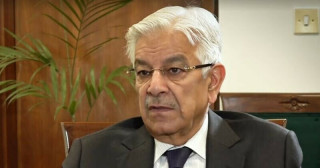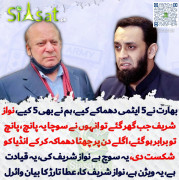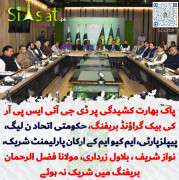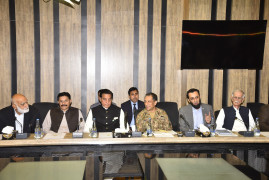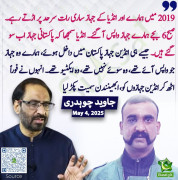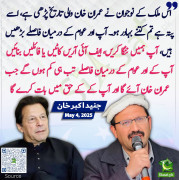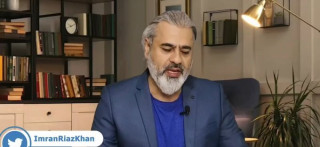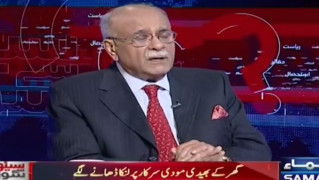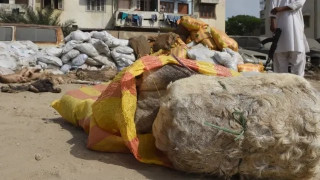[h=2][/h] Urbanization in Pakistan Highest in South Asia


Urbanization is not just a side effect of economic growth; it is an integral part of the process, according to the World Bank. With the robust economic growth averaging 7 percent and availability of millions of new jobs created between 2000 and 2008, there has been increased rural to urban migration in Pakistan to fill the jobs in growing manufacturing and service sectors. The level of urbanization in Pakistan is now the highest in South Asia, and its urban population is likely to equal its rural population by 2030, according to a report titled Life in the City: Pakistan in Focus, released by the United Nations Population Fund. Pakistan ranks 163 and India at 174 on a list of over 200 countries compiled by Nationmaster.
Pakistan has and continues to urbanize at a faster pace than India. From 1975-1995, Pakistan grew 10% from 25% to 35% urbanized, while India grew 6% from 20% to 26%. From 1995-2025, the UN forecast says Pakistan urbanizing from 35% to 60%, while India's forecast is 26% to 45%. For this year, a little over 40% of Pakistan's population lives in the cities.
The urban population now contributes about three quarters of Pakistan's gross domestic product and almost all of the government revenue. The industrial sector contributes over 27% of the GDP, higher than the 19% contributed by agriculture, with services accounting for the rest of the GDP.

A 2008 report by UN Population Fund says the share of the urban population in Pakistan almost doubled from 17.4 percent in 1951 to 32.5 percent in 1998. The estimated data for 2005 shows the level of urbanization as 35 per cent, and CIA Factbook puts it at 36% in 2008, and it is increasing with 3% of the nation's population migrating to cities every year. With over 5 million rural migrants each year, the population of Pakistani cities in exploding, and Karachi has now become the world's largest city, according to Citymayors.com.
India's urban residents in 2008 account for 29% of its population, and the CIA Fact Book estimates it growing at 2.4% of the total population every year.
In 2007, analysts at Standard Chartered bank estimated that Pakistan has a middle class of 30 million which earns an average of about $10,000 per year. And adjusted for purchasing power parity (PPP), Pakistan's per capita GDP is approaching $3,000 per head. An expected positive consequence of the increasing urbanization of society in Pakistan will be the creation of over 100 million strong middle class by 2030. This large urban population will not only create a domestic market for goods and services, but it can create a skilled work force that can be the engine of economic growth and source of innovation.

According to the 1998 census, Sindh is the most urbanized province with 49 percent percent of the population living in urban centers. NWFP is the least urbanized province with only 17 percent of its population living in urban areas.
The shares of urban population in Punjab and Balochistan in 1998 were 31 and 23 percent respectively. There has been a visible narrowing down of the growth rate differentials among provinces, although the urban population in Balochistan and Islamabad has been increasing at higher rates of 5.1 and 5.8 percent respectively.

More than 60 percent of the population of urban Sindh lives in Karachi and this concentration has increased over time. Approximately three-quarters of the total urban population of Sindh are concentrated in just three urban centers: Karachi, Hyderabad and Sukkur. Karachi is growing so fast that estimates of its population range from 12 million to 18 million. The country's financial capital is also a city where about half the population lives in sub-standard housing.
National Public Radio(NPR), an American radio network, did a series recently on a massive wave of urbanization sweeping the world's emerging economies such as Brazil, China, India and Pakistan. It chose to start with Karachi, which it described as Pakistan's "economic lifeline" and financial and industrial "powerhouse" that produces 25% of Pakistan's GDP, and called it "one of the largest and most crowded cities of the world".
In Punjab, 22 percent of the urban population lives in Lahore, and half of the total provincial urban population lives in five large cities.
Peshawar has a population of approximately one million without counting the Afghan refugees, which is 33 percent of the urban provincial population. The share of Quetta in the total urban Balochistan population was 37 percent.
More than half of the total urban population of Pakistan lived in 2005 in eight urban areas: Karachi, Lahore, Faisalabad, Rawalpindi, Multan, Hyderabad, Gujranwala and Peshawar. Between 2000 and 2005, these cities grew at the rate of around 3 percent per year, and its projected that this growth rate will continue for the next decade.
Along with increasing internal rural to urban migration, there has also been a wave overseas migration from urban areas in Pakistan to urban centers overseas, especially the Middle East. The Middle East, with its vast oil wealth, has provided many opportunities for overseas workers to work and earn a living building and maintaining infrastructure in various Arab states, especially in the Persian Gulf. In recent years, overseas Pakistanis have been contributing to Pakistan's economy with remittances exceeding $7 billion a year.
There are many benefits of rural to urban migration for migrants' lives, including reduction in abject poverty, empowerment of women, increased access to healthcare and education and other services. Historically, cities have been driving forces in economic and social development. As centers of industry and commerce, cities have long been centers of wealth and power. They also account for a disproportionate share of national income. The World Bank estimates that in the developing world, as much as 80 percent of future economic growth will occur in towns and cities. Nor are the benefits of urbanization solely economic. Urbanization is associated with higher incomes, improved health, higher literacy, and improved quality of life. Other benefits of urban life are less tangible but no less real: access to information, diversity, creativity, and innovation.
At the same time, there are many issues caused by the current wave of urbanization, including the fact that massive increases in urban population create more and larger urban slums, increase the potential for environmental deterioration, and bring tremendous pressures on city services already strained beyond limits. Take sanitation, for example, and it is no surprise that three major South Asian cities, Dhaka, Mumbai and New Delhi, show up on the Mercer's list of world's 25 dirtiest cities. Some non-government organizations, such as the Orangi Pilot Project (OPP) in Karachi, are stepping in to fill the huge gaps left by the municipal authorities. Under OPP guidance, between 1981 and 1993 Orangi residents installed sewers serving 72,070 of 94,122 houses. To achieve this, community members spent more than US$2 million of their own money, and OPP invested about US$150,000 in research and extension of new technologies.
Like any growing megacity in the developing world, Karachi has its share of problems. Pollution, crime, corruption and political volatility are just some of the issues confronting the 12 million to 18 million "Karachiites" who call this overcrowded city home. Karachi is 60 times larger than it was when Pakistan was created in 1947. And with the population growing at an annual rate of 6 percent, one of the biggest challenges for city officials is managing the tensions and violence that often flare along ethnic and religious lines.
In a recent interview with Wall Street Journal, Pakistan's former finance minister Salman Shah explained that "Pakistan has to be part of globalization or you end up with Talibanization". "Until we put these young people into industrialization and services, and off-farm work, they will drift into this negative extremism; there is nothing worse than not having a job," Shah elaborated. But increasing urbanization in South Asia represents both a challenge and an opportunity for India, Pakistan and Bangladesh. It is a challenge because it imposes a rapidly growing burden on the already overcrowded megacities such as Mumbai, Delhi, Dhaka and Karachi. Such a massive challenge will require a tremendous focus on providing housing, transportation, schooling, healthcare, water, power, sanitation and other services at an accelerated pace. But if this challenge can be successfully met, there will be an opportunity to develop the human potential of the rural poor and employ them more productively in the growing industrial and services sectors in the cities. In the case of Pakistan, if the level of robust economic growth, human development and increased urbanization can be sustained to significantly enlarge the South Asian nation's middle class, then there can be hope for genuine and durable democracy to thrive.
http://www.pakpositive.com/pakistan...l&nextT=Five Rupees&pU=http://www.riazhaq.com
SOURCE:


Urbanization is not just a side effect of economic growth; it is an integral part of the process, according to the World Bank. With the robust economic growth averaging 7 percent and availability of millions of new jobs created between 2000 and 2008, there has been increased rural to urban migration in Pakistan to fill the jobs in growing manufacturing and service sectors. The level of urbanization in Pakistan is now the highest in South Asia, and its urban population is likely to equal its rural population by 2030, according to a report titled Life in the City: Pakistan in Focus, released by the United Nations Population Fund. Pakistan ranks 163 and India at 174 on a list of over 200 countries compiled by Nationmaster.
Pakistan has and continues to urbanize at a faster pace than India. From 1975-1995, Pakistan grew 10% from 25% to 35% urbanized, while India grew 6% from 20% to 26%. From 1995-2025, the UN forecast says Pakistan urbanizing from 35% to 60%, while India's forecast is 26% to 45%. For this year, a little over 40% of Pakistan's population lives in the cities.
The urban population now contributes about three quarters of Pakistan's gross domestic product and almost all of the government revenue. The industrial sector contributes over 27% of the GDP, higher than the 19% contributed by agriculture, with services accounting for the rest of the GDP.

A 2008 report by UN Population Fund says the share of the urban population in Pakistan almost doubled from 17.4 percent in 1951 to 32.5 percent in 1998. The estimated data for 2005 shows the level of urbanization as 35 per cent, and CIA Factbook puts it at 36% in 2008, and it is increasing with 3% of the nation's population migrating to cities every year. With over 5 million rural migrants each year, the population of Pakistani cities in exploding, and Karachi has now become the world's largest city, according to Citymayors.com.
India's urban residents in 2008 account for 29% of its population, and the CIA Fact Book estimates it growing at 2.4% of the total population every year.
In 2007, analysts at Standard Chartered bank estimated that Pakistan has a middle class of 30 million which earns an average of about $10,000 per year. And adjusted for purchasing power parity (PPP), Pakistan's per capita GDP is approaching $3,000 per head. An expected positive consequence of the increasing urbanization of society in Pakistan will be the creation of over 100 million strong middle class by 2030. This large urban population will not only create a domestic market for goods and services, but it can create a skilled work force that can be the engine of economic growth and source of innovation.

According to the 1998 census, Sindh is the most urbanized province with 49 percent percent of the population living in urban centers. NWFP is the least urbanized province with only 17 percent of its population living in urban areas.
The shares of urban population in Punjab and Balochistan in 1998 were 31 and 23 percent respectively. There has been a visible narrowing down of the growth rate differentials among provinces, although the urban population in Balochistan and Islamabad has been increasing at higher rates of 5.1 and 5.8 percent respectively.

More than 60 percent of the population of urban Sindh lives in Karachi and this concentration has increased over time. Approximately three-quarters of the total urban population of Sindh are concentrated in just three urban centers: Karachi, Hyderabad and Sukkur. Karachi is growing so fast that estimates of its population range from 12 million to 18 million. The country's financial capital is also a city where about half the population lives in sub-standard housing.
National Public Radio(NPR), an American radio network, did a series recently on a massive wave of urbanization sweeping the world's emerging economies such as Brazil, China, India and Pakistan. It chose to start with Karachi, which it described as Pakistan's "economic lifeline" and financial and industrial "powerhouse" that produces 25% of Pakistan's GDP, and called it "one of the largest and most crowded cities of the world".
In Punjab, 22 percent of the urban population lives in Lahore, and half of the total provincial urban population lives in five large cities.
Peshawar has a population of approximately one million without counting the Afghan refugees, which is 33 percent of the urban provincial population. The share of Quetta in the total urban Balochistan population was 37 percent.
More than half of the total urban population of Pakistan lived in 2005 in eight urban areas: Karachi, Lahore, Faisalabad, Rawalpindi, Multan, Hyderabad, Gujranwala and Peshawar. Between 2000 and 2005, these cities grew at the rate of around 3 percent per year, and its projected that this growth rate will continue for the next decade.
Along with increasing internal rural to urban migration, there has also been a wave overseas migration from urban areas in Pakistan to urban centers overseas, especially the Middle East. The Middle East, with its vast oil wealth, has provided many opportunities for overseas workers to work and earn a living building and maintaining infrastructure in various Arab states, especially in the Persian Gulf. In recent years, overseas Pakistanis have been contributing to Pakistan's economy with remittances exceeding $7 billion a year.
There are many benefits of rural to urban migration for migrants' lives, including reduction in abject poverty, empowerment of women, increased access to healthcare and education and other services. Historically, cities have been driving forces in economic and social development. As centers of industry and commerce, cities have long been centers of wealth and power. They also account for a disproportionate share of national income. The World Bank estimates that in the developing world, as much as 80 percent of future economic growth will occur in towns and cities. Nor are the benefits of urbanization solely economic. Urbanization is associated with higher incomes, improved health, higher literacy, and improved quality of life. Other benefits of urban life are less tangible but no less real: access to information, diversity, creativity, and innovation.
At the same time, there are many issues caused by the current wave of urbanization, including the fact that massive increases in urban population create more and larger urban slums, increase the potential for environmental deterioration, and bring tremendous pressures on city services already strained beyond limits. Take sanitation, for example, and it is no surprise that three major South Asian cities, Dhaka, Mumbai and New Delhi, show up on the Mercer's list of world's 25 dirtiest cities. Some non-government organizations, such as the Orangi Pilot Project (OPP) in Karachi, are stepping in to fill the huge gaps left by the municipal authorities. Under OPP guidance, between 1981 and 1993 Orangi residents installed sewers serving 72,070 of 94,122 houses. To achieve this, community members spent more than US$2 million of their own money, and OPP invested about US$150,000 in research and extension of new technologies.
Like any growing megacity in the developing world, Karachi has its share of problems. Pollution, crime, corruption and political volatility are just some of the issues confronting the 12 million to 18 million "Karachiites" who call this overcrowded city home. Karachi is 60 times larger than it was when Pakistan was created in 1947. And with the population growing at an annual rate of 6 percent, one of the biggest challenges for city officials is managing the tensions and violence that often flare along ethnic and religious lines.
In a recent interview with Wall Street Journal, Pakistan's former finance minister Salman Shah explained that "Pakistan has to be part of globalization or you end up with Talibanization". "Until we put these young people into industrialization and services, and off-farm work, they will drift into this negative extremism; there is nothing worse than not having a job," Shah elaborated. But increasing urbanization in South Asia represents both a challenge and an opportunity for India, Pakistan and Bangladesh. It is a challenge because it imposes a rapidly growing burden on the already overcrowded megacities such as Mumbai, Delhi, Dhaka and Karachi. Such a massive challenge will require a tremendous focus on providing housing, transportation, schooling, healthcare, water, power, sanitation and other services at an accelerated pace. But if this challenge can be successfully met, there will be an opportunity to develop the human potential of the rural poor and employ them more productively in the growing industrial and services sectors in the cities. In the case of Pakistan, if the level of robust economic growth, human development and increased urbanization can be sustained to significantly enlarge the South Asian nation's middle class, then there can be hope for genuine and durable democracy to thrive.
http://www.pakpositive.com/pakistan...l&nextT=Five Rupees&pU=http://www.riazhaq.com
SOURCE:



